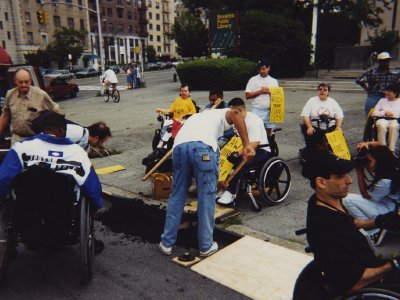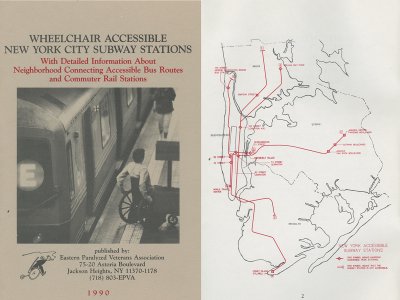How did we get here? Transportation Access in New York
There are many ways to get around the city. You can walk, drive (or be driven) in a car or a bus, ride the subways and trains, or cross the water in a ferry. All forms of transportation have been made more accessible in the past 50 years, but there are still access barriers today.
At one point in time, it was very hard or impossible for people with disabilities to travel alone using any type of transportation. And, different disabled communities have different needs. For example, people who are blind need audio announcements, those who are deaf need visible information, and wheelchair users need elevators and ramps. People with intellectual disabilities and developmental disabilities may need travel training to learn to navigate independently.
Of course, there are planes to fit into and airports to navigate (and there have been many efforts to improve those experiences, too). And, everyone needs access to toilets when they travel, but those fights are stories for another day! As a result of advocacy, things have improved. In 1994, New York became the first city to make all its local buses wheelchair accessible. But there are still problems. Express buses often have broken lifts, and bus operators don’t always know how to help disabled passengers. Sometimes people in wheelchairs get stuck and can’t get off the bus. This happened to Disabled In Action president, Jean Ryan, who told the MTA board in July 2025.
Disabled New Yorkers have fought hard—and continue to fight—to improve transportation for everyone. Some of their biggest victories are still unfolding around us. Learn about how things used to be and how they will change in the future.
Accessible Transit Traveler
After the ADA passed, EPVA wrote the Accessible Transit Traveler. The brochure explained the changes that were supposed to be made by transportation agencies. It also outlined deadlines for making the improvements. EVPA fought for access to all forms of transportation
1990 Booklet from the Eastern Paralyzed Veterans Association (EPVA) Collection.
Eastern Paralyzed Veterans Association (EPVA)
EPVA led the fight for accessible public transit in the NYC area before the ADA. They campaigned for accessibility in all kinds of mass transportation, including subways, buses, commuter rail, and ferries.
Top: c. 1980s Poster from the Carr Massi Collection Bottom: c 1990s. Photos from the EPVA Collection

Walking
Walking connects people to places and other modes of transportation. People who use wheelchairs still “walk,” and they credit their freedom and independence to their wheelchairs.
Read about objects
Automobiles
In New York City, cars, taxis, and for-hire vehicles are reliable ways for people with disabilities to get around. But they haven’t always been fully accessible.
Read about objects
Paratransit
People who relied on cars advocated for a public paratransit option that was affordable and accessible.
Read about objects
Buses
Today’s buses have low floors and ramps that fold out for wheelchair users. But older buses were much harder to use.
Read about objects
